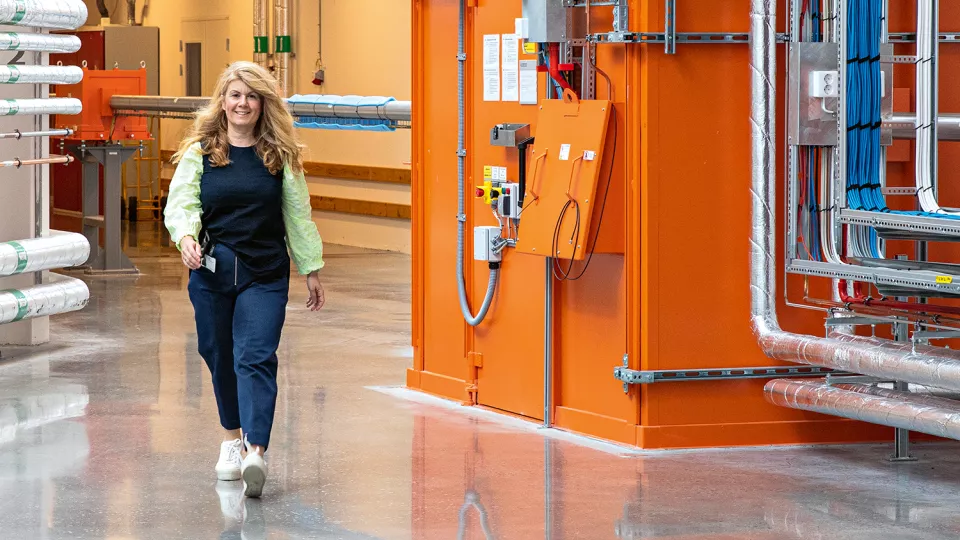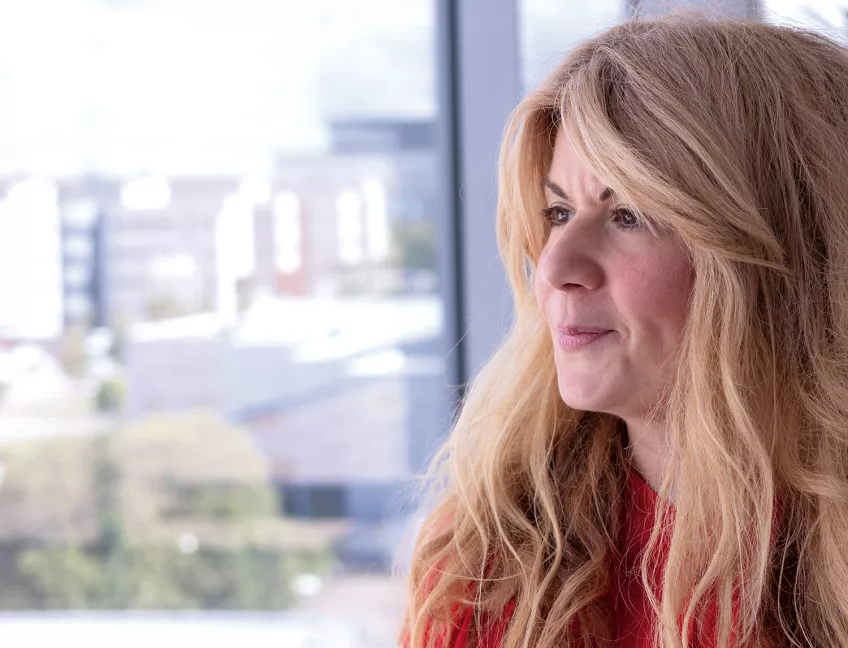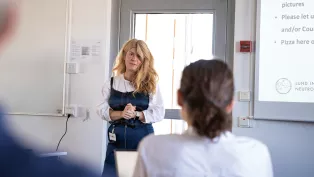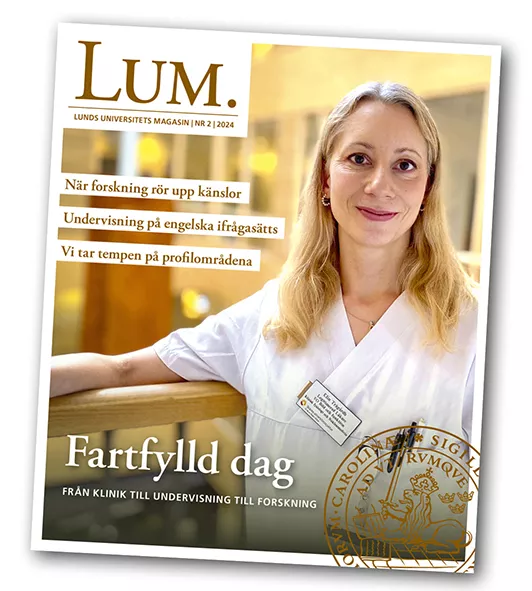Her worldview may have been affected by her flight from former Yugoslavia, says the synchrotron and neutron researcher, who changed course in 2018 and is currently the business and industry coordinator at MAX IV.
“I often talk about the war. There is a before and an after”, she says.
In 1993, when she was only 13, she was forced to flee from the city of Mostar with her mother, father and brother, who is two years older. The war broke out in 1992, with the disintegration of former Yugoslavia. The bombs and grenades that rained down from the hills became the new background to daily life. There were holes in all the walls.
“At first, we ran down to the cellar during the attacks. But later on, we stayed outside playing until we heard the first explosions.”
Her mother saved them
Almost on the very day Selma Maric turned 13, everything changed. In May 1993, the street she lived on turned into a no man’s land. Her flat was shot at by snipers. Whether you are Muslim, Catholic or Orthodox Christian could determine the difference between life and death. For a week, her family was forced to
“We had to abandon everything: our passports, clothes and money, and we could not go back to get our things because of the snipers.”
From Mostar, their escape took them to the home of Selma Maric’s maternal aunt and then on to Croatia. From there, they wanted to travel to Scandinavia via Eastern Europe. Selma’s mother tried to sell her rings to pay for the journey. Her father took out a loan. Still the money was not sufficient.
“I will never forget how my father told the bus driver who was to smuggle us on to Poland that he would set fire to himself if we weren’t allowed on the bus. It was so terrible”, she says, getting emotional about the memory, although she is otherwise cheerful during our interview.
Came to Sweden by chance
The bus journey was the only time in Selma Maric’s life when she has been really hungry. They came to Sweden by chance. When the bus arrived at the Polish port of Świnoujście, the ferry for Denmark had just left.
“We were granted asylum quickly”, she says. “The month after we arrived, the Swedish border closed…”
The family was given accommodation in various refugee facilities in the Stockholm area. That period was marked by waiting and tedium. On TV, Selma saw how the bridge in Mostar was blown up.
“As a refugee you are in limbo. You wait: to be told that you can stay, for an apartment, for education.”
Her first words in Swedish were: could I have a cup of coffee? She learned the phrase from a cassette player that the family had bought. The taped course was designed for tourists.
After a few months, the family got its first apartment at last, in Skarpnäck in Stockholm, and a small starter loan.
“We went to IKEA and bought four of each item: four beds, four forks, four knives. We had to start from scratch and bought the cheapest of everything. My father was so proud when he paid back the loan.”
Difficult being a teenager in a new country
Selma Maric started in seventh grade, having missed several years of school because of the war. She stopped speaking, despite knowing Swedish by then.
“It was really hard. My classmates already knew each other. They had lovely new clothes. I spoke differently and my brother and I shared a winter jacket – the same jacket shared by the whole family when we lived in the refugee facility. There were so many codes that I didn’t understand.”
Schoolwork, piano lessons and her best friend from Mostar, who lived on the same street in Skarpnäck, were beacons of light in her existence.
When Selma started on the Science programme in upper secondary school, things changed. She was one of three girls in the class.
“I decided: I don’t want to be silent any longer; I am not someone who doesn’t talk! It became important to show people who I was.”
When she was 20 she moved away from home, earlier than her brother, and despite her parents’ initial aversion.
“This was not done in my culture, you were to get married and have children, not move to your own apartment. But I didn’t accept my parents treating my brother and me differently. And my parents listened to me.”
From chemical engineering to MAX IV
“I decided I would go to Australia to learn more about infectious diseases. I wanted to cure malaria”, she recalls.
In Australia, she laid the basis for what would become her first research article, about how proteins from the malaria parasite behave when they come into contact with metal ions.
After her degree, it took a long time for Selma to get a job. It was hard because her Swedish fellow students were quickly offered employment. IN the end, she got a job as a chemist and technical manager at Proctor and Gamble.
But what she really wanted to do was research.
“Above all, I wanted to work with protein structures. Why does the protein look the way it does? How do drugs bind to proteins, for example?”
In the end, she got a doctoral studentship from the Niels Bohr Institute at the University of Copenhagen. One and half months later, she was in a major neutron facility, the Institut Laue-Langevin in Grenoble, where she was able to conduct experiments with large x-ray and neutron tools.
“It was an awesome feeling! These were big tools and major labs. Before I started my PhD studies, I didn’t know anything about ESS, the European Synchrotron Radiation Facility, or MAX IV.”
After completing her thesis, in which she developed a method for studying membrane proteins in solutions using neutron scattering, Selma returned to Stockholm for a post-doc position at Karolinska Institutet, in drug design and x-ray crystallography. But only a year later, she left for Malmö University to start neutron and synchrotron research on how lipids are stored in the arteries.
“I have not followed a classic path, where you first earn a PhD, then travel to the USA and then start a research team. I have never shied away from ending things if something else shows up. I only have one life and I have to do what is most interesting and exciting.”
Wants to stand up for herself and others
Selma Maric often returns to her ambition to stand up for herself and others, and to benefit society. This engagement is a theme throughout her life, from the teenager who helped others in their contacts with public authorities on arrival in Sweden and protested against injustices, to the researcher who wants to eradicate malaria, and now in her role as a bridge-builder between academia and industry.
“When I was younger, I wanted to save the world. Find new drugs and eradicate diseases. I used to think that if you weren’t trying to improve things, you were part of the problem.”
In 2015, when hundreds of thousands of Syrians fled their country for the EU and Sweden, she got involved with offering internships to Syrian chemists at Malmö University. Not a single intern showed up.
“It may be different now, but my experience was that the asylum applicants were not offered the right help to get out into working life.”
Her parents were 39 and 43 when they arrived in Sweden. They have managed to build successful careers here, but they do not have many Swedish friends.
“I often feel conflicted. My old country no longer exists today. It is a huge departure to flee – and it is difficult to integrate into Swedish society.”
Today, her ambition to contribute has taken a new form. After three years as a post-doc at Malmö University, she is working as the business and industry coordinator at MAX IV. A job that is about building bridges between the MAX IV research facility, academia and industry.
The choice to abandon research was anything but obvious, however, even though she had already gone from studying how proteins function to cure diseases, over to developing new research methods. Methods that are currently applied at several international research facilities.
“Although I wanted to work at MAX IV, leaving research was an identity crisis. Suddenly I couldn’t lean on my role as a researcher. It was difficult in the beginning, but then I realised that my new job was a lot more than what I had expected.”
She is still doing a little research while working on projects destined to open the facilities up to industry.
“For these projects, it is a major advantage that I have worked with these tools myself and I can make more of a difference than an individual researcher. That is my motivation; helping more people. I can contribute to more researchers being appointed, and to more funding applications to develop new methods and tools. “
Working within academia is anything but easy, she adds.
“I am happy to have done research. It is extremely creative to start things that can lead to so much. But as a junior researcher, you are very vulnerable. It is badly paid, difficult to get a job, and you live with great uncertainty. In many cases, you have to apply for funding for your own salary.”
She doesn’t think too much about the future and the next step in her career.
“I am quite satisfied with what I have achieved so far, within membrane-lipids, protein research and method development. But I still want to improve things! Help more people, train more people! Quite simply to be more useful."





